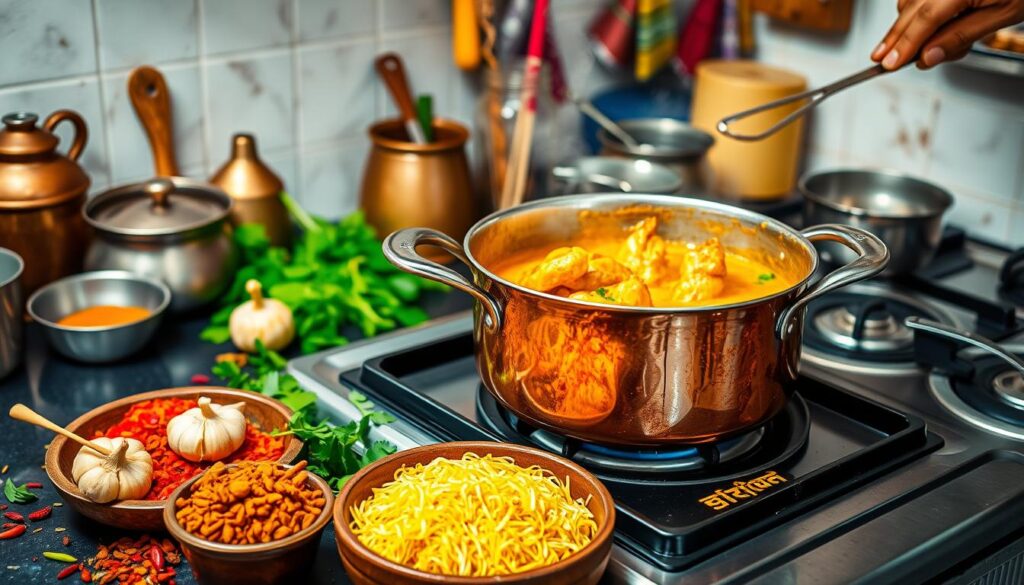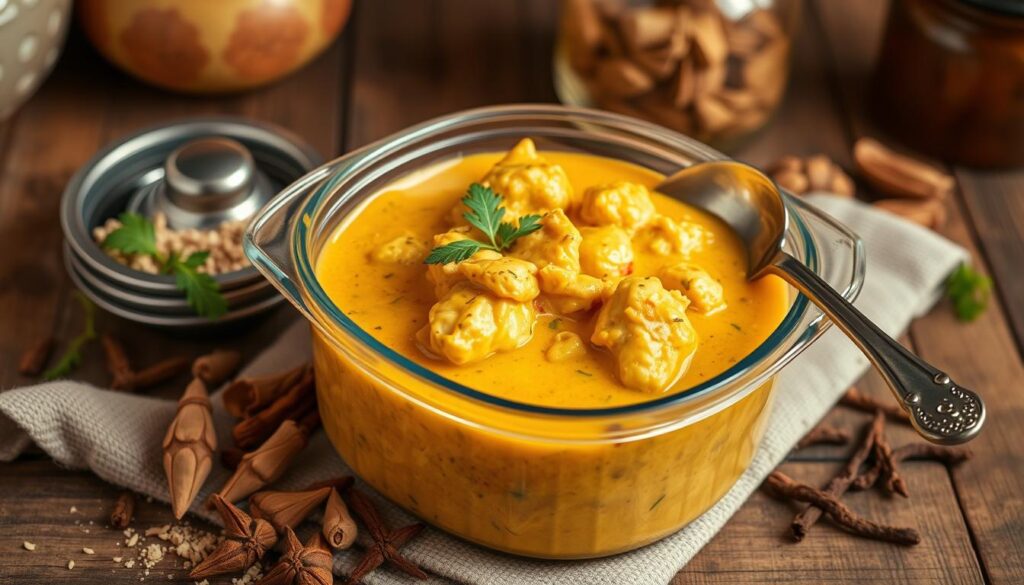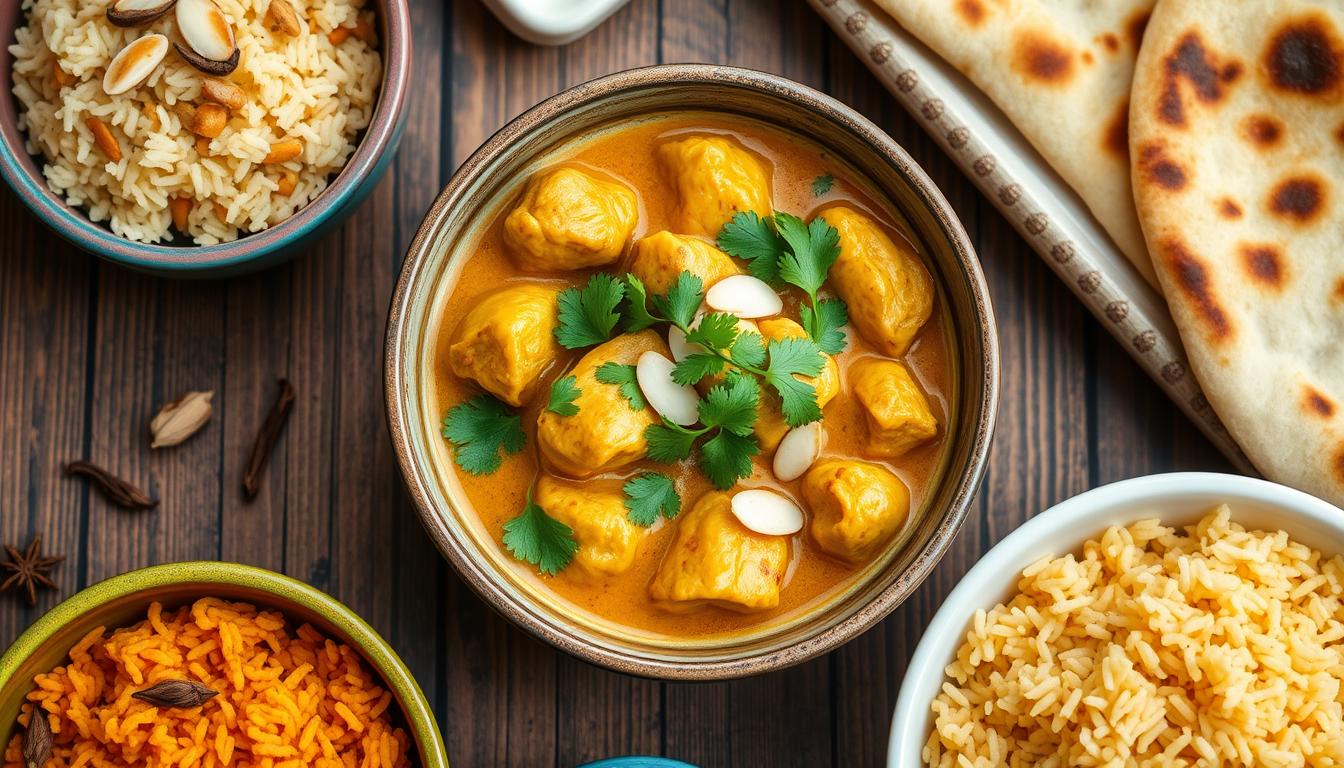Chicken Korma is a rich, creamy Authentic Indian Curry that highlights the flavors of Mughlai cuisine. This Creamy Chicken Dish mixes marinated chicken, aromatic spices, and a luxurious sauce. It’s a treat for anyone, whether you’re new to Indian food or a seasoned fan.
Get ready for a flavorful adventure with this Mughlai Cuisine gem. Chicken Korma balances creaminess, spice, and depth perfectly. It’s sure to excite your taste buds and leave you wanting more. Enjoy it with basmati rice, naan, or paratha for a meal that feels like a trip to India.
Table of Contents
What is Chicken Korma?
Chicken Korma is a favorite North Indian curry dish. It comes from the Mughal cuisine, known for its rich flavors. The word “korma” means “to braise” in Urdu. Today, korma can be made with chicken, paneer, or vegetables.
A Brief History of Korma
Korma has its roots in the Mughal era in India. It was a favorite of the royal court. The dish is known for its creamy texture and aromatic spices.
As the Mughal empire grew, korma recipes changed. They adapted to local ingredients and cooking styles. This led to many regional variations.
Origins of Chicken Korma
Chicken Korma is a popular version of the classic korma. It uses chicken, which is mild and tender. This makes the curry appealing to many people.
Chicken Korma cooks faster than kormas made with red meat. This makes it more convenient for many.
Popular Variations Across Regions
- North Indian Korma: Made with yogurt, cream, and nuts for a rich texture.
- South Indian Korma: Uses coconut, seeds, and nuts, without dairy.
- Hyderabadi Korma: Known for its vibrant red color and unique spice blend.
- Kashmiri Korma: Features Kashmiri chili, fennel, and warm spices like cinnamon and cardamom.
Chicken Korma is loved for its creamy, mild flavor. It’s enjoyed across the Indian subcontinent and worldwide.
Key Ingredients Needed for Chicken Korma
Making a real Chicken Korma needs the right mix of ingredients. These ingredients work together to bring out the dish’s unique flavors. From the Korma Spices to the Chicken Selection and Flavor Enhancers, each part is crucial. They all help make the dish creamy, rich, and mildly spiced, just like it should be.
Spices for Authentic Flavor
The spice mix is at the heart of Chicken Korma. You’ll need:
- Cardamom
- Cloves
- Cinnamon
- Cumin
- Coriander
- Turmeric
These spices, along with ginger, garlic, and onions, create the dish’s flavor base.
Types of Chicken to Use
For the best Chicken Korma, use bone-in chicken like thighs or legs. Bone-in chicken gives a deeper flavor than boneless. But, if you want a lighter dish, boneless chicken works too.
Optional Add-ins for Extra Flavor
There are extra ingredients that can make Chicken Korma even better:
- Saffron, for a vibrant color and aroma
- Kewra or rose water, for a floral fragrance
- Cashews or almonds, for a creamy, nutty texture
- Yogurt or cream, for a smooth, velvety finish
Choosing and mixing these ingredients right can make a Chicken Korma that’s truly memorable. It captures the essence of this beloved Indian dish.
Essential Equipment for Cooking Korma
To make a delicious Korma Cooking Tools dish, you need the right kitchen tools. From the pot to the spice grinder, each tool is key. They help get the perfect mix of textures and smells.
Recommended Cooking Pots
Choose a heavy-bottomed pan or Dutch oven for the best taste. Their thick base spreads heat evenly, stopping the sauce from burning. A Indian Cookware with a tight lid keeps the steam in. This makes the chicken tender and the flavors strong.
Tools for Spice Grinding
Freshly ground spices are essential for a real Spice Grinders Korma. Use a mortar and pestle or electric grinder to make fine spice powder. A strong blender is great for smooth onion and nut pastes, adding depth to the dish.
Serving Suggestions and Utensils
Put the Korma Cooking Tools Korma in traditional Indian bowls. Serve with a ladle for easy serving. Basmati rice, naan, or paratha are perfect sides, letting you enjoy every bit of the sauce.
With the right Indian Cookware and tools, you’ll get better at making Korma. You’ll give your guests a memorable dining experience.
Preparing the Chicken for Korma
Marinating the chicken is key to making a delicious Chicken Korma. It adds a rich spice flavor and tenderizes the meat. For the best taste, use yogurt, ginger-garlic paste, and spices in the marinade.
Marinating Chicken: Tips and Tricks
Start with bone-in chicken pieces for the juiciest Korma. You can also use ¾ lb of boneless chicken. Mix the chicken with yogurt, ginger-garlic paste, and spices like coriander and turmeric. Make sure the marinade covers the chicken evenly.
Then, cover the bowl and chill it for at least 30 minutes. Or, marinate it overnight for even more flavor.
Importance of Time in Marination
The longer the chicken marinates, the better it tastes. Aim for at least 30 minutes. But for the best flavor, marinate it for 2-3 hours or overnight.
This long marination time makes the meat tender and flavorful. It removes any raw taste, making the Chicken Korma even better.
“The secret to a truly exceptional Chicken Korma lies in the marination process. The longer you let the chicken soak in the aromatic blend of spices and yogurt, the more tender and flavorful the final dish will be.”
Making the Korma Base
Making a great Korma base is key to a delicious Chicken Korma. Start by frying onions until they’re golden brown or caramelized. This step is important for the flavor of the whole dish.
Frying Onions to Perfection
Frying onions takes time and patience. Cook them slowly over medium heat, stirring now and then. They should turn a rich, caramelized color. This can take 15 to 25 minutes, depending on the onions and your stove.
Being patient is crucial. Let the onions’ natural sugars cook down. This makes a sweet and savory base for the Korma.
Making a Flavorful Paste
After the onions are caramelized, blend them into a smooth paste. Use a food processor or blender with onions, nuts like cashews or almonds, and yogurt. Blend until it’s creamy and velvety. Some recipes use boiled onion paste for a milder taste.
This paste is the heart of the Korma base. It’s where the sauce for the chicken comes from. The quality of this base greatly affects the dish’s taste and texture. So, make sure to get it right.
Cooking Techniques for Chicken Korma
Chicken Korma can be made in different ways to get the right taste and texture. You can use sautéing or slow cooking, each with its own benefits.
Sautéing vs. Slow Cooking
Sautéing cooks the chicken quickly over high heat before simmering it in the korma sauce. This method seals in the juices and gives the chicken a nice sear. It makes the flavor more intense.
On the other hand, slow cooking lets the flavors blend over time. This makes the chicken tender and juicy.
Managing Cooking Time
Getting the cooking time right is crucial for a great Chicken Korma. It usually simmers for 15-20 minutes until the chicken is tender and the sauce thickens. But, the time can change based on the chicken type.
Bone-in chicken might need more time than boneless chicken thighs. Adjusting the time ensures the chicken is cooked and the flavors mix well.

Both sautéing and slow cooking can make a tasty Chicken Korma. It’s about finding what works best for you and your cooking style.
Common Mistakes While Making Chicken Korma
Making Chicken Korma is all about the right mix of spices and cooking skills. Even skilled cooks can run into common problems. Let’s look at some Korma Cooking Errors to avoid. This way, you can get Texture Perfection and enjoy the Spice Balance Tips that make it special.
Overcooking the Chicken
One big mistake is overcooking the chicken. This makes it dry and tough, ruining the dish’s creamy feel. To avoid this, watch your cooking time closely. Cook the chicken until it’s tender but still juicy.
Misbalancing Spices
Getting the spice mix right is key for Chicken Korma. Too much of some spices can overpower the dish, while too little makes it taste flat. Be careful with the spice amounts in the recipe. Adjust them to your taste for a balanced flavor.
| Common Chicken Korma Cooking Errors | Recommended Fixes |
|---|---|
| Overcooking the Chicken | Monitor cooking time closely to prevent dryness |
| Misbalancing Spices | Carefully measure and adjust spice quantities to achieve the right flavor profile |
| Excessive Use of Yogurt | Limit yogurt to maintain the dish’s creamy, balanced texture |
| Grainy Onion Paste | Blend the onion paste thoroughly to ensure a smooth consistency |
By avoiding these common mistakes and using the right Spice Balance Tips, you’ll get better at making Chicken Korma. You’ll achieve the Texture Perfection that makes it a true culinary joy.
Serving Suggestions for Chicken Korma
Chicken Korma is a versatile dish that pairs beautifully with a variety of accompaniments. To truly savor the rich, creamy flavors of this Indian classic, consider serving it with some of these delightful options.
Best Side Dishes to Pair With
- Plain steamed basmati rice: The fluffy texture and neutral flavor of basmati rice provides the perfect canvas for the flavorful Korma.
- Butter naan: The soft, buttery naan bread is an excellent choice for sopping up the delectable Korma sauce.
- Tandoori roti: The charred, slightly crisp texture of tandoori roti complements the creaminess of the Korma.
- Parathas: These flaky, layered Indian flatbreads add an extra dimension of flavor and texture to the Korma experience.
Recommended Rice and Bread Options
For a more flavorful rice accompaniment, consider serving the Chicken Korma with ghee rice, cumin rice, or turmeric rice. These aromatic rice varieties provide a delightful foil to the rich Korma sauce.
To further enhance the dining experience, consider offering cooling accompaniments like raita (a yogurt-based condiment) or lassi (a refreshing yogurt-based drink). These can help balance the creamy, indulgent nature of the Chicken Korma.
Finally, garnish the Chicken Korma with fresh coriander leaves and, for added texture and visual appeal, consider topping it with fried onions or sliced almonds.
“The key to an exceptional Chicken Korma experience lies in the perfect balance of flavors and textures. By pairing it with the right accompaniments, you can truly elevate this dish to new culinary heights.”
Storing Leftover Chicken Korma
Chicken Korma’s rich flavors don’t have to end with the last bite. With the right storage, you can enjoy it for days. These tips will help you store and reheat Chicken Korma like a pro.
Proper Storage Techniques
To keep your Chicken Korma’s taste and texture, store it right. Cool the curry and put it in an airtight container. Refrigerate it for 2-3 days. For longer storage, freeze it for up to 3 months. Use a freezer-safe container to avoid freezer burn.
Reheating Tips
To reheat Chicken Korma, use gentle heat. This prevents the sauce from separating and the chicken from drying. Reheat it over medium heat, stirring often. If it’s too thick, add a bit of water or cream.
Make sure the Korma heats up to 165°F (74°C) before serving. This ensures food safety and brings back the delicious taste.
“Proper storage and reheating techniques are the key to enjoying your Chicken Korma leftovers to the fullest.”
Follow these tips to store and reheat Chicken Korma. This way, you can enjoy its flavors even after the first meal.

Chicken Korma for Special Occasions
Chicken Korma is perfect for your next special event. It’s great for an intimate dinner or a big celebration with family and friends. Its mild, creamy taste is loved by many.
Ideal Occasions for Serving
Chicken Korma is a star at an Indian Dinner Party or a Festive Korma Recipe for Korma for Events. It’s a favorite at holidays, birthdays, and casual gatherings.
How to Impress Your Guests
- Serve the Chicken Korma in copper or brass bowls for a classy look.
- Offer naan, roti, or basmati rice for guests to make their own meal.
- Make a vegetarian korma too, for guests with different diets.
- Decorate with fresh herbs, flowers, or gold leaf for a fancy touch.
With these tips, your Chicken Korma will be a hit. It will impress your guests and leave them talking about your cooking.
“Chicken Korma is a true celebration of flavors, perfect for any special occasion. Its rich, creamy texture and aromatic spices make it a crowd-pleasing favorite.”
Nutritional Information of Chicken Korma
Chicken Korma is a tasty and creamy dish from India. But, it’s key to know its nutritional facts. A serving has 797 calories, with 46% carbs, 25% fat, and 29% protein.
Caloric Breakdown of Ingredients
The calories come from cream, nuts, and ghee. A serving has 24g of fat, 4g of saturated fat, and 1,065mg of sodium. Yet, it’s rich in protein with 64g per serving and has fiber, vitamins, and minerals too.
Healthier Korma Options
To make Chicken Korma healthier, try these changes:
- Use low-fat yogurt instead of heavy cream to cut down on fat and calories.
- Choose lean chicken breast to lower saturated fat.
- Add a cashew-based paste for creaminess and extra nutrients.
- Cook with olive oil instead of ghee for better heart health.
- Top it with cauliflower rice or roasted veggies for more fiber and nutrients.
These tweaks let you enjoy Chicken Korma’s flavor while eating a healthier meal.
Conclusion: Why You’ll Love This Chicken Korma Recipe
This homemade Chicken Korma recipe is a perfect mix of authentic flavors and simple steps. It’s a dish that you can make your own, fitting it to your taste and needs. Cooking Korma at home means you get to pick the ingredients and how spicy it is, making it a cozy and tasty experience.
Encouragement to Try the Recipe
If you’re new to Indian food or love curries, this Chicken Korma is a great start. Its mild spices make it a dish that everyone can enjoy, perfect for family meals or parties. Try making Korma at home and experience the delight of this traditional recipe.
Final Thoughts on Flavor and Tradition
Chicken Korma is more than just a tasty dish; it’s a piece of Indian culinary history. This recipe keeps the traditional cooking alive while meeting today’s tastes. By making Korma yourself, you enjoy a delicious meal and connect with the cultural heritage behind it. Enjoy the mix of spices, the creamy texture, and the warmth of a dish loved for generations.

